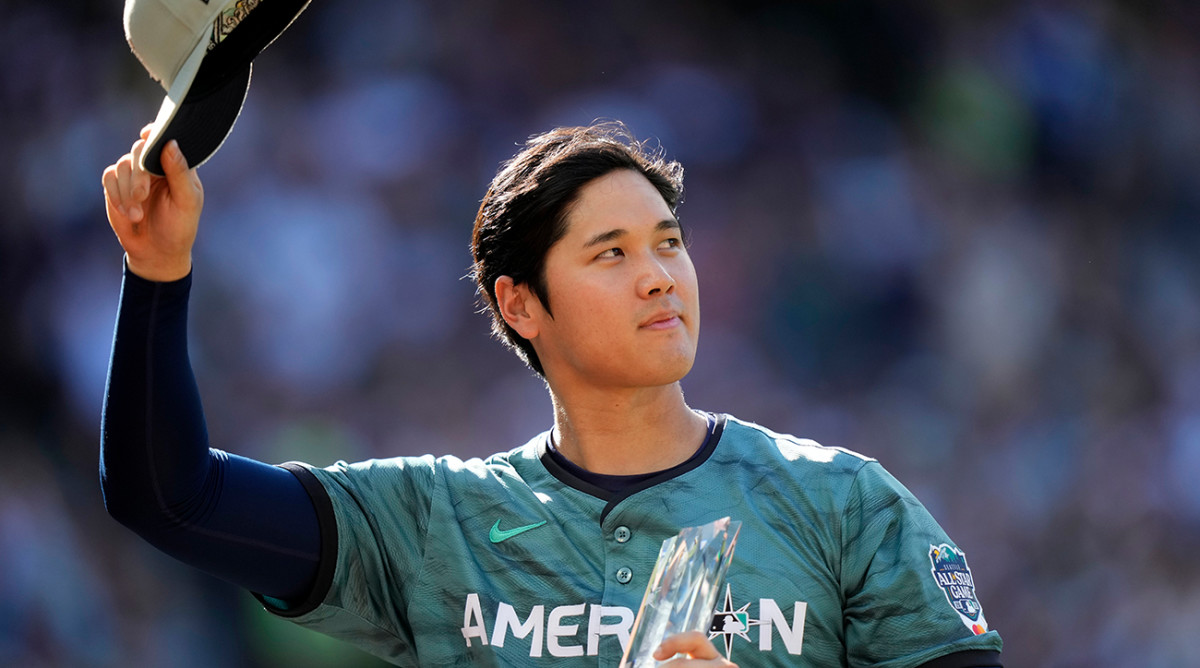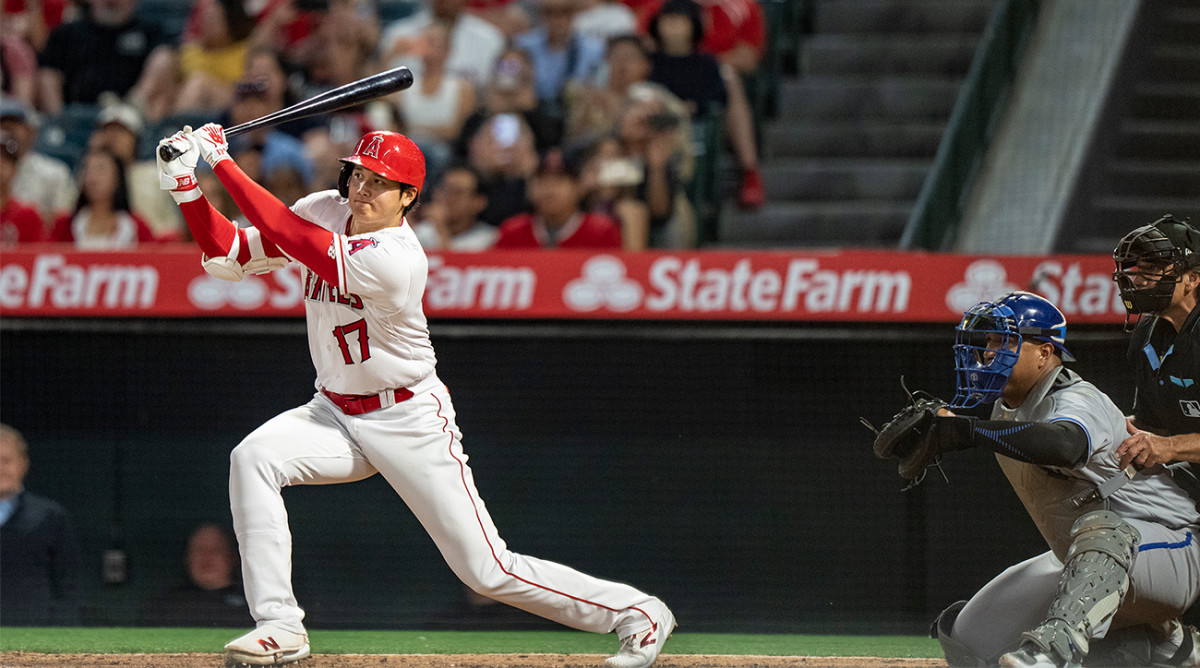Shohei Ohtani Is the Center of the Baseball Universe

Editor’s Note: This story was published July 12, following an All-Star Game week in which Shohei Ohtani seemingly kick-started his free agency sweepstakes. The Angels megastar was crowned American League MVP for the second time in his illustrious career Thursday.
Shohei Ohtani did not put a ball in play in the All-Star Game on Tuesday—he walked and struck out in his two plate appearances—but such is the outsized wonder and appeal of Ohtani that the 93rd Midsummer Classic became about him.
The 3–2 win by the National League and the emotional home run by Elias Díaz of the Rockies were thrilling in their own ways. Díaz was once DFA’d by the Pirates, he wears the name of his mother, Ana, on his chest protector (she was once kidnapped in Venezuela and rescued three days later) and made his first All-Star Game at 32—15 years after signing as a pro. To see him cry when thanking his family upon being named MVP was a beautiful tribute to perseverance.

But most of all, the game was the unofficial kickoff to the Ohtani recruiting sweepstakes, the prelude to the greatest free-agent derby the game has ever seen. More than 40,000 people at T-Mobile Park greeted each of his two plate appearances with chants of “Come to Seattle!” And with Mike Trout and Aaron Judge out of the game with injuries, the other All-Stars spent much of their time here answering questions about Ohtani and his future. Ohtani was the lead singer. Everybody else was part of the backup band.
Angels owner Arte Moreno is of no mind to trade Ohtani. The thought that he could lose Ohtani after the season through free agency “for nothing” is not on his radar. He still believes the Angels can make a September postseason run when Trout returns. That’s unlikely; they are five games out of a wild-card spot and hold a 3.9% chance of reaching the playoffs, according to Baseball Reference. But the way Moreno sees it, he owes it to Trout, Ohtani and Angels fans to exhaust the possibility. He also continues to have Ohtani chasing records, locking up the MVP and entertaining fans in an Angels uniform. All that is not “nothing” to Moreno.
If, however, the Angels continue to slide out of contention badly enough in the next two weeks, general manager Perry Minasian must play the logical efficient counterbalance to Moreno’s emotional ties and argue to at least consider offers for Ohtani. But the obstacles to a satisfactory deal are huge. Take the best fit, the Dodgers, off the board. Moreno would never trade his best asset to the rival Dodgers and—based on trade deadline discussions last year—it would take a team’s best major league hitter and best major league pitcher to convince Moreno to pull the trigger. He is a star-driven owner who will not be swayed by a package of prospects and the idea of “rebuilding” around his investment in Trout.
Once Ohtani is a free agent, the Dodgers will be the most likely team to sign him. They check all the boxes: They can pay top dollar; they offer the West Coast weather and location that suit him best; and they give him the chance to contend for the World Series every year of a long-term contract while affording him his one-every-sixth day pitching schedule. The leading contenders after Los Angeles, in order: (2) Padres, (3) Giants, (4) Mariners, (5) Rangers, (6) Mets.
When Ohtani was asked about prioritizing a chance to play in the postseason, his translator, Ippei Mizuhara, characterized what Ohtani said as, “Those feelings get stronger year by year. It sucks to lose. He wants to win. That gets stronger every year.”
Ohtani proved what winning means to him with his spectacular play and resolve in the World Baseball Classic. It wasn’t just that Ohtani closed the championship game after running back and forth from the bullpen in between at bats. It was also that it was Ohtani who led the clubhouse meeting before the game, telling his Team Japan teammates about playing Team USA, “If we idolize them, we can’t surpass them. We’ve come here to surpass them and to reach the top. Just for today, let’s get rid of our adoration for them and think about nothing but winning. Let’s go!”
He proved it in the All-Star Game when he told manager Dusty Baker before the game that he wanted to take three at bats—no early dive out of the game and off to the private jet for him.
And really, he proves it every night with his inexhaustible energy to pitch and hit for what is a third full season. Baker, for instance, marveled at how Ohtani can hold his stuff on the mound so deep into games (batters hit .210 against him third time around) and wondered how he could build up the kind of endurance that historically has required intense running programs from pitchers.
But Ohtani doesn’t run. To do so would create diminishing returns due to how hard his legs work already with his labor as a hitter and base runner. Ohtani stays strong through plyometrics (band resistance work) and robust dedication to his nutrition and sleep that goes back to his days at Hanamaki Higashi High School.
When Ohtani first entered high school, he was so tall and slender he scarfed down extra food at lunch, snacked between meals and ate chocolate crepes at night to gain weight. But when he injured his hip as a sophomore and took six months off from pitching, he grew serious about his eating and sleeping habits. He is fanatical about sleep and its recovery value.

At 29, Ohtani is in peak form, save an annoying blister on his throwing hand that is creating a two-week break from pitching. The double-jointedness of his shoulders and elbows allows him hyperflexibility with his throwing motion. The broadness of his shoulders and length of his limbs—a former swimmer, he is built like Michael Phelps—give him extraordinary leverage in the batter’s box.
If this is not the apex of his career it is scary to think what that might be. As it is, he is chasing 62 home runs, the Triple Crown and the best strikeout rate and lowest batting average allowed by any pitcher—in his walk year into free agency ... after ramping up early to compete at his highest level in the WBC.
When he was in high school, Ohtani was so enamored with the idea of testing himself in the major leagues he asked teams in Nippon Pro Baseball not to draft him. He had met with the Dodgers, Red Sox, Rangers and Orioles. Undeterred, Nippon Ham Fighters GM Masao Yamada drafted him with the first pick, anyway. It was considered a huge risk to spend the pick on a player who seemed bound for MLB.
Manager Hideki Kuriyama provided the clincher to get Ohtani to sign. “Travel down a path no one else walked,” he told Ohtani, which played to Ohtani’s desire to be a two-way player. His development in a major league organization, Kuriyama told him, might not allow him such freedom to chase his dream.
When Ohtani signed, about 150 people turned out for the press conference. The Fighters gave him uniform No. 11, which had belonged to Yu Darvish. As a kid, Ohtani idolized Darvish and patterned his delivery off the one of Darvish. At his first workout for the Fighters, about 30 media people reported on every throw and swing of his day.
He has performed in the spotlight every day of his professional career. And with every season he improves, be it smoothing out his pitching mechanics with the Fighters, adding a two-seamer and a sweeper with the Angels or cutting down on his strikeouts this year to become a .300 hitter. It’s all been done with an unwavering dedication to baseball. He tracks every practice throw, every workout, every swing and every minute of precious sleep with the exactitude of a NASA engineer.
It has carried him here, to the talk of the All-Star Game and the center of the baseball universe. Others have excelled longer or had higher peaks, but when it comes to mastering two diverse disciplines that historically cleave the best players in two groups, Ohtani is the most extraordinary baseball talent who has ever lived.
This is not Juan Soto nor Justin Verlander nor Max Scherzer, all of whom have been traded at the deadline. This is not even Bryce Harper, whom the Nationals nearly traded to Houston but simply could not bring themselves to do so. They are stars, but not like Ohtani.
As the chants at T-Mobile Park proved, this is someone unlike anyone else. It is why, if you are Moreno, you may want to keep this treasure for as many days as you can.
Stray All-Star Game Notes
- MLB reached out to Reds rookie Elly De La Cruz to see whether he was interested in taking part in the Home Run Derby, according to a league source. He was not. The commissioner has the right to add “special exemptions” to All-Star teams, the way veterans Albert Pujols and Miguel Cabrera were added last year, but adding De La Cruz after only 30 games in the majors did not carry enough “earned” weight and may have added pressure to the rookie.
- Total All-Star Game activity by Yankees, Mets and Red Sox: one inning from Gerrit Cole and two hitless at bats from Pete Alonso. Times have changed.
- Arizona ace Zac Gallen fanned Ohtani in the first inning with a nasty 3-and-2 knuckle-curveball. Says Gallen, “I was ready to just challenge him with a fastball but [catcher Sean] Murphy called for the breaking ball. I just went with it. I go, ‘I can do that’ and just stuck with Murph.”
- Harper should be good to go when the second half begins Friday, Phillies manager Rob Thomson said. Harper missed a game Sunday after getting hit by a pitch on his surgically repaired right elbow. Harper expects to be playing first base before the month is over—a position that could be his long-term home.
